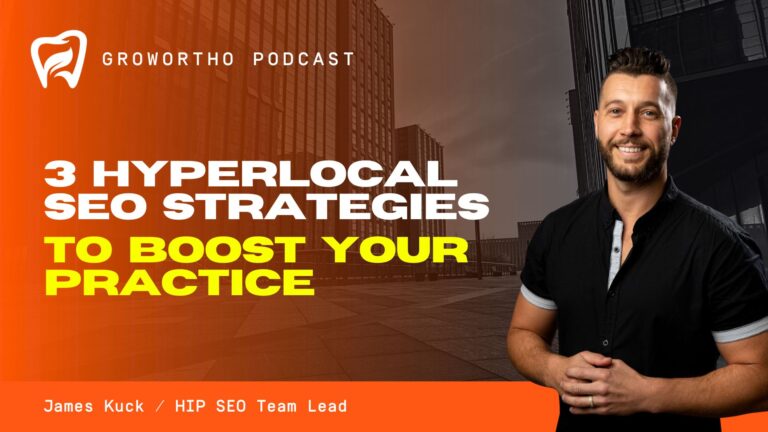Subscribe: RSS
Why Your Local SEO Isn’t Working Beyond Your City Limits
If you feel weirdly invisible to people just 20 or 30 minutes away, you’re not imagining it.
You’ve done the basics. Website? Check. City name in a few headings? Done. Google Business Profile? Live. On paper, you’re doing local SEO.
In reality, you’re only visible to a thin slice of the people who could realistically become patients.
The practices quietly winning are doing something different. They’re not just doing SEO for their city. They’re building a strategy around specific neighborhoods, suburbs, and nearby towns. They’re sending Google extremely clear signals about where they want to show up and why they deserve to be there.
That’s hyperlocal SEO.
Local SEO vs Hyperlocal SEO — Why The Difference Matters
Most marketing conversations blur these two together. Start by separating them in your mind.
Local SEO is usually “We’re an orthodontist in [city].” Your city name lives in title tags and H1s. A Google Business Profile ties to your address. Maybe a service area list sits buried in a footer. That used to be enough.
Hyperlocal SEO is different. It focuses on specific nearby towns, suburbs, and neighborhoods, not just your main city. It’s built around how people actually search in those areas: “orthodontist in Pace” or “braces near Lake Nona.” It’s supported by real content and signals for each area, not just listing town names in a paragraph.
Why does this matter?
Because Google cares about proximity and relevance at a granular level now. Someone searching from a small town outside a metro isn’t just seeing the best site in the big city. Google is trying to answer: “Who is truly the best and most relevant option for this specific person, in this specific place, at this moment?”
If your competitors are sending stronger signals for those surrounding areas, you’ll lose those searches even if you’re objectively the better practice.
Start With Where Patients Actually Come From
The biggest mistake practices make with SEO is guessing.
You don’t need to guess. You already have data in your practice management system and inside your own head.
Ask a few simple questions. Which towns, suburbs, or rural communities do your current patients actually live in? Where do people commonly tell you they’re driving in from? Which areas feel like a natural extension of your community, and which don’t?
If you sit down and list this out, you’ll end up with a set of realistic service areas.
For example, if your practice is in Pensacola, you might pull in patients from Gulf Breeze, Pace, Milton, or farther out. If you’re in Orlando, you might see people from Lake Nona, Dr. Phillips, Winter Garden, or Clermont.
That list is your starting point.
Then layer in your ideal patient. Are you primarily serving adults or families? Do you have a strong aligner focus, or are you braces heavy? Are you trying to attract young professionals, busy parents, or retirees?
Different neighborhoods have different mixes of those people. A retiree-heavy community might not be your priority if you’re trying to become the go-to practice for kids and teens. A high-growth suburb of young families might be a perfect target if you want more Phase I and full treatment cases.
The most important part: your SEO partner can’t know this on their own. You live in this market every day. You know which areas feel aligned and which don’t. When you share that information openly, it changes the entire strategy.
Turn Your Real Service Area Into Hyperlocal Targets
Once you know where your patients come from and where you want to grow, you can convert that into actual SEO targets.
Start small and focused.
Pick three to five priority areas around your main office. These are places where people already come from, or you’re confident people would come from if they actually knew you existed.
For each of those, you’ll eventually want a clear understanding of how people in that area search for care, a dedicated content plan that speaks directly to them, and strong signals to Google that your practice is relevant to that area.
This is where the difference between mentioning a town and owning it in search really starts to show.
Build Real Hyperlocal Assets, Not Throwaway Mentions
Hyperlocal SEO shows up in two main places: your website and your Google Business Profile.
On Your Website
Most practices do this wrong by simply dropping a list of towns at the bottom of their homepage.
Something like: “We serve patients from Pensacola, Gulf Breeze, Pace, Milton and the surrounding areas.”
Google looks at that once, shrugs, and keeps rewarding the site that actually built content around those areas.
Instead, create dedicated neighborhood or town pages. Each priority area gets its own page. For example, “Orthodontist in Pace,” “Braces for kids in Gulf Breeze,” or “Clear aligners in Lake Nona.”
These pages shouldn’t be fluff. They should explain who you are and why patients from that area choose you. Talk about how far you are, how easy it is to get to you, and why the drive is worth it. Include the treatments you want to promote in that area. Reflect something real about that community, not generic copy.
Structure them so Google understands what they’re about. That means using the town or neighborhood name in the page title and main heading. Include related phrases people actually type, like “[neighborhood] orthodontist” or “braces near [neighborhood].” Write clear, helpful content that a real parent or adult would find useful, not keyword soup.
Use your competitors as a guide, not a template. Look at who already ranks for “orthodontist in [town]” or “[town] braces.” Study how long their pages are, what questions they answer, and how they talk about the area. Then build something at least that robust, but in your own voice and with your own strengths.
On Your Google Business Profile
Your Google Business Profile is often the first impression someone has of you. It needs to support your hyperlocal strategy.
Make sure the towns and neighborhoods you want to attract are listed correctly in your service areas. This doesn’t replace real content, but it adds another signal. Publish posts that directly reference the areas you care about and the services you want to grow. For example, a post about “Braces for teens in Gulf Breeze” featuring a real patient story. When possible, patients mentioning the town they live in in reviews can be a subtle but powerful reinforcement of your relevance to that area.
Avoid The Common Hyperlocal SEO Traps
There are a few patterns that quietly sabotage hyperlocal efforts.
Trap One: Thin, Copy-Paste Pages
Creating 20 neighborhood pages that say basically the same thing with the city swapped out is worse than doing nothing. Google can see through it and users bounce as soon as they sniff generic content.
Better to have three or four strong, thoughtful pages than 20 weak ones.
Trap Two: Trying To Be For Everyone, Everywhere
If you tell your SEO partner, “We want to rank for everything in a two-hour radius,” you’ll end up spreading budget and focus too thin.
You know there are certain areas that don’t make sense for your practice, whether because of drive time, demographics, or competition. Say that out loud. It helps you double down where you can actually win.
Trap Three: Thinking Rankings Are The End Goal
The point isn’t just to be number one for “orthodontist in [town].”
The point is families are willing to drive 30, 45, even 60 minutes because they feel like you’re the right fit. Your messaging, reviews, and experience all back up what they saw in search. New patients who live outside your main city come in already warm, not skeptical.
SEO gets them to your door. Your brand and experience are what turn them into starts and referrals.
Measure Whether Hyperlocal Is Actually Working
You never want to pour energy into this and then have no idea whether it moved the needle.
Here’s how to track it.
Watch Your Hyperlocal Keywords
Make sure your reporting includes “[Town] orthodontist,” “[Town] braces,” “[Town] Invisalign” or “clear aligners in [town],” and variations with “near me” and “near [town].”
Look for movement from not ranking at all to being on page two or page one. Watch for climbing up the map pack rankings for those phrases over time.
It won’t be instant, but you should see momentum if your content and structure are solid.
Use Your Analytics
In Google Analytics or whatever tracking you use, watch where website sessions are coming from geographically. Look at whether visits from target towns and zip codes are increasing. Check whether those visitors are spending time on the site and converting, not just bouncing.
You want to see growth from towns that previously contributed very little traffic.
Listen To What Patients Say
This part isn’t fancy, but it’s powerful.
Train your front desk or treatment coordinator to ask new patients two simple questions: “How did you hear about us?” and “Where are you driving in from today?”
When you start hearing answers like “We were looking for an orthodontist in [town] and found you on Google” or “We’re driving about 45 minutes, but your reviews and website made us feel comfortable,” that’s proof your hyperlocal work isn’t just moving rankings. It’s changing behavior.
A Simple Hyperlocal Action Plan You Can Start This Month
To make this feel manageable, here’s a simple sequence you can follow.
Week One: Map Your Real Service Area
List all towns, suburbs, and rural communities that already send you patients and you want more of in the future. Circle the top three to five you believe have the most potential.
Week Two: Audit Your Footprint
On your website, highlight everywhere those towns are mentioned now. Note which ones have dedicated pages and which are only in footers or random paragraphs. On your Google Business Profile, check that your service areas reflect your real service area. Review your recent posts. Are any of them explicitly speaking to those specific towns?
Weeks Three to Six: Build Your First Wave of Hyperlocal Content
Create one new neighborhood or town page per week for your top priorities. Make each page focused on how people in that area actually search, specific about why people from there come to you, and strong enough that you’d be proud to send a friend there if they asked for information. Publish one or two Google Business posts each week centered around those towns and one key service.
Ongoing: Review and Refine
Every quarter, look at keyword rankings for your hyperlocal phrases, traffic and calls from target areas, and what new patients say when you ask where they’re coming from.
As certain areas respond well, you can repeat the process for new neighborhoods or towns around your office, just like adding rings around a hub.
Bringing It All Together
Hyperlocal SEO isn’t a trick or a hack. It’s simply aligning your digital presence with the way people actually live, search, and decide.
Most practices will stay stuck at the “we did SEO for our city” level and wonder why they keep losing out on patients from 20 or 30 minutes away.
You don’t need to be one of them.
If you start with real patient behavior instead of assumptions, pick a focused set of neighborhoods and towns, build real, specific content that speaks to those communities, and track what actually happens on your site and in your new patient consults, you can transform your website and Google profile from a static brochure into a real driver of growth beyond your immediate neighborhood.
You know your community. A good SEO partner knows how to translate that into structure, content, and signals that search engines understand.
When you bring those two together, you don’t just rank. You become the obvious choice for the right people, even if they have to drive a little farther to get to you.



